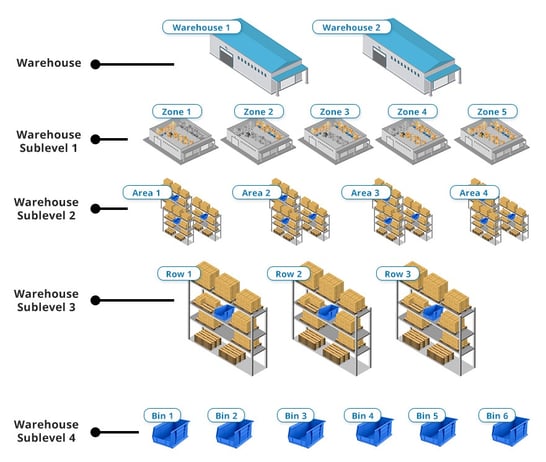SAP Business One® application offers best-practice functionality to help you meet your inventory and production management requirements. One feature, bin locations, enables users to set up your warehouse is zones to better manage inventory. Read more.

Inventory represents one of the largest expenses for many small and midsize enterprises (SMEs). Balancing accurate inventory management with cost-effective production is crucial for delivering on customer promise and keeping satisfaction high.
The SAP Business One solution offers best-practice functionality to help SMEs meet their inventory and production management requirements. One feature, bin locations, enables users to set up a warehouse as zones to better manage inventory. So what exactly is a bin location and how does it work?
What is a Bin Location?
A bin location can be defined as the smallest unit of space in a warehouse where goods are stored. The following diagram provides an example of a company that has two warehouses and how bin locations subdivide the space.

By codifying your products' bin locations in SAP Business One, workers can locate products more efficiently in the warehouse. For example, a bin location code such as 1-ZONE2-AREA3-ROW1-BIN3 is much more descriptive than storing components or goods on an empty shelf without any specific organisation.
There are several types of bin locations in SAP Business One. When used correctly, bin locations can speed up the process of receipts and issues of inventory in your bin locations.
Receiving Bin Locations
This bin location is an area designated in a warehouse where goods are inspected and temporarily stored. Once an inspection is carried out, goods are then moved to storage bin locations.
- To designate a bin location as a receiving bin location, select the Receiving Bin Location checkbox in the Bin Location Master Data window.
- SAP Business One can automatically place the incoming products in the receiving bin locations of an SME's warehouse.
Storage Bin Location
This bin location is a place designated in the warehouse to store goods. To indicate a bin location is a storage bin location, users must leave the Receiving Bin Location checkbox in the Bin Location Master Data window unselected.
Default Bin Location
A bin location used to store incoming goods by default. SAP Business One lets you specify the default bin locations on the following three levels:
-
Warehouse
Helps users specify information about the warehouse an SME uses. -
Item Group
Item groups help users describe the type of good. So if an SME has in its inventory a large number of goods, this allows for a generalised description, or if there are few items in the inventory a more detailed description. -
Item
Users can specify the default bin location for an inventory item.
System Bin Location
A System bin location is predefined by SAP Business One for each warehouse that an SME has enabled the bin location function. The bin location code in SAP Business One follows the format <Warehouse Code><Bin Location Code Separator>SYSTEM-BIN-LOCATION.
The default setting for SAP Business One's bin location is the warehouse's default bin location. The system uses this bin location for receiving and issuing goods automatically if it is the only bin location in a warehouse. By default, the system bin location is where SAP Business One will store items that have been received externally from vendors or customers. For example, if there's a item transfer from another warehouse or if an SME takes receipt of a finished product from a factory.
Warehouse and Production Management with SAP Business One
The SAP Business One application offers best-practice functionality to help you meet your inventory and production management requirements. To learn more about inventory management features such as bin locations, download the Warehouse and Production Management with SAP Business One brochure.


